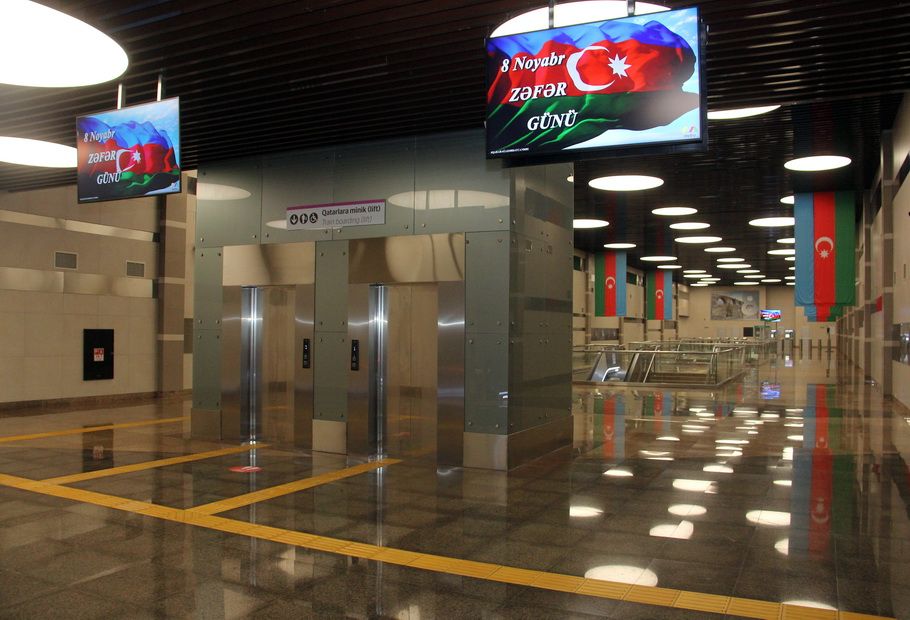
May 29, 2021
Purple
Nasimi district, Jeyhun Salimov street
Jahangir Sadikhov
144 m
"November 8th" Station
The "November 8th" station has carved a unique place in the history of Baku Metro, standing alongside significant historical milestones such as May 28 and January 20. This station, which is the 26th station of Baku Metro and the 3rd on the Purple Line, was named in honor of Victory Day, November 8, following the initiative of the President of the Republic of Azerbaijan and the Supreme Commander-in-Chief of the Armed Forces, Mr. Ilham Aliyev. It was opened for public use on May 29, 2021. This marks another extension of the metro line starting from the "Avtovagzal" station, covering a planned length of 18.5 km from Khojasan village to Qaracukhur, integrating another segment - the "Memar Ajami-8 November" area - into the city's underground transportation network. Since its inauguration, the station has seen a steady increase in passenger numbers, now serving over 3,000 commuters daily.
Three-Level Station
Situated opposite the Central Military Clinical Hospital on Jeyhun Salimov Street, the station connects the Nasimi district area with the city center and several other districts. The total length, including the transition chamber and passenger platform, is 363.34 meters.
The "November 8th" station consists of three levels. It has four exits to Jeyhun Salimov Street, two of which are towards the bridge on Abdulvahab Salamzade Street on both directions of the road, and one exit leads towards the residential area by the hospital.
From the surface level, passengers can access the station using escalators, lifts, and stairs. The top level houses the entrance area and ticketing zones. In the future, it's planned to connect with the Blue Line (from Yasamal residential area to Bakikhanov suburb) with a pedestrian tunnel starting from this station.
The second level, designated for technical purposes, houses the electrical supply, ventilation, signaling, communication, and other essential station equipment. Service rooms on this level contain infrastructure critical for operation management. Passengers can move from this transitional level to the vestibule and then to the platform via escalators and stairs. In total, 17 of the most modern "Tugela FT-945" type escalators by ThyssenKrupp facilitate the flow of passengers through the station across all four exits. Like other stations on the line, "November 8th" is equipped with three "Enta-200" type lifts by ThyssenKrupp for physically challenged passengers, ensuring the metro is accessible to everyone. Since March 2019, a dedicated service has been operational for passengers using wheelchairs, providing easy access to the platform and designated spaces on trains.
Architectural and Design Scheme
The depth of the "November 8th" station varies from 12 to 22 meters, tailored to the terrain's relief. The "Ground Wall" construction method, first used in the Purple Line’s "Memar Ajami" station, has been applied here too, ensuring construction efficiency in a compact area while addressing ecological considerations optimally. The construction utilized new building techniques and modern global standards machinery, enhancing the overall efficiency and effectiveness of the construction.
All entrances and exits are covered with canopy-style roofs, adding aesthetic value to the surrounding area while protecting escalators and stairs from the elements.
The station, from its entrance to the platform, follows a unified architectural ensemble characterized by simplicity and original solutions. The platform, capable of accommodating seven-car trains, features walls clad in ceramic granite and floors laid with granite.
The station's lighting, designed in the most modern style, not only saves electricity but also adds an aesthetic dimension to the design. Circular lights create a spacious effect, enhancing the station's ergonomic and aesthetic appearance and deepening the corridor's breadth with a lit hall effect.
Tunnels Connecting to "Memar Ajami" Station
The tunnels connecting the Purple Line's "Memar Ajami" and “November 8th” stations were constructed using the latest tunneling machines. The tunnels from the "Avtovağzal" station were dug with machinery from Germany's "Herrenknecht" and the USA's "Robbins".
Spanning over 1250 meters, the "Memar Ajami-8 November" section features trackways built on precast concrete blocks for the first time in Baku metro's history, providing a durable, maintenance-friendly solution well-suited to complex hydrogeological conditions. These blocks are produced by the "Baku Metro's" own new facility, established in collaboration with Germany's "Vollert" company, using cutting-edge technology. This approach significantly reduces operational costs and prevents capital outflow.
The track structure was assembled using the "Vollert-Rheda" system, incorporating the highly efficient "Vossloh-300 UTS" rail fasteners and new-type turnout devices. It's worth noting that the "Vollert-Rheda" system was introduced for the first time in any of the former USSR metro systems here in Baku. The R-54 type new turnouts, made by Spain's "Voestalpine," ensure smoother and faster transitions between tracks. The Spanish-made contact rails also contribute to this innovation, meeting relevant standards. Made from aluminum, these contact rails are more durable and maintenance-friendly than their predecessors, reducing electricity consumption by up to 25%.